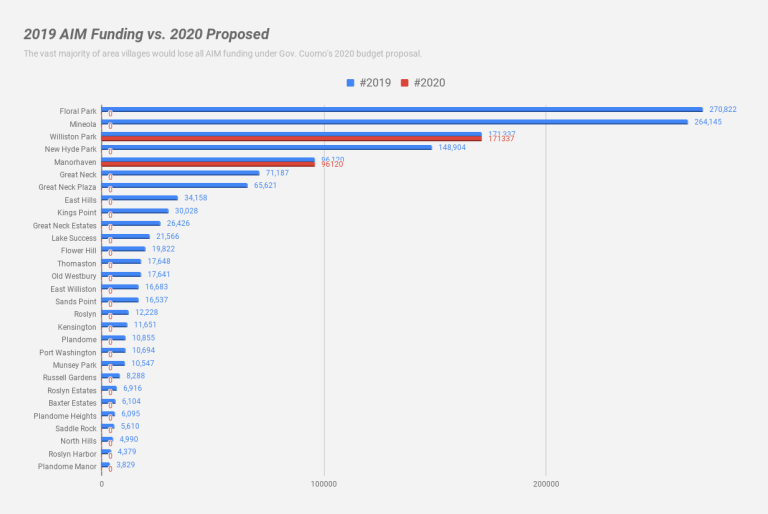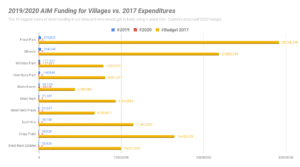
The vast majority of villages in Nassau County and statewide could lose funding from the state’s Aid to Municipalities program, according to the governor’s latest budget proposal, raising concerns among some current and former village officials about taxation and budget stress.
Only two of 29 area villages would retain any so-called AIM – or aid to municipalities – funding, according to the governor’s proposal. This would mean that $1.39 million of funding would decrease to $267,457 – the product of Manorhaven’s $96,120 and Williston Park’s $171,337.
The aid would make up more than 2 percent of Manorhaven and Williston Park’s respective budgets, according to the state. The average across area villages was 0.67 percent.

Ralph Kreitzman, the executive director of the Nassau County Village Officials Association and a former mayor of Great Neck, said that number may seem small.
But villages are “limited severely” in how they can raise revenue and facing drastically increasing costs, he said, while the $19.7 million all villages statewide received last fiscal year would only be one one-hundredth of 1 percent of the proposed $172 billion budget.
“Our hope is that when we can give these facts to our state legislators that they will realize that this, although a small amount of the state budget, is very very important to the villages,” Kreitzman said.
Peter Baynes, the executive director of the New York Conference of Mayors, also urged the governor to reverse course and for state legislators to fight the changes.
“When it comes to local governments and the property tax reform, the Governor’s budget fails to abide by its theme of ‘justice,’ as it would eliminate state aid for the vast majority of New York’s smallest local governments,” Baynes said. “If the goal this legislative session is to enact progressive tax reform, it will not be achieved by cutting local aid and removing municipalities’ ability to follow through on their goal to reduce the regressive property tax burden.”
Three villages made up more than half the losses in the area: Floral Park, Mineola and New Hyde Park.
Floral Park would no longer get $270,822 in help, worth 0.93 percent of its 2017 expenditures, according to the state. Mineola would lose $264,145 in funding, which equals about 1.21 percent of its $21.88 million of spending in 2017. New Hyde Park, meanwhile, would lose $148,904 – worth 1.85 percent of its 2017 expenditures of $8.06 million.
“Any cut, anywhere makes spending difficult for any government,” Floral Park Mayor Dominick Longobardi said. “Right now the village is absolutely barebones. The Village of Floral Park will experience a major loss of revenue as a result of the cut and will have to look very hard at services it provides to make sure residents don’t receive a tax raise.”
The New Hyde Park’s village trustees and mayor are also opposed to the proposal to eliminate state aid, village Clerk Janet Bevers said.
In Nassau County, only five of its 64 villages would keep getting state help. The AIM funding for the county’s villages would drop from $5.64 million to only $754,184.
Williston Park Mayor Paul Ehrbar said the funding for his village, one of the few that would still get AIM funding, helps offset expenses and keep property taxes down.
“It came out in our favor this time,” Ehrbar said of the governor’s plan to keep providing aid to Williston Park.
Great Neck Plaza Mayor Jean Celender said that for her village, which passed a $7.3 million budget and could lose $65,000 of state assistance, every dollar counts in trying to stay under the state tax cap.
“We’re really trying and we try really hard to stay under the tax cap,” she said on Wednesday, noting ever-increasing expenses and the village’s pursuit of grants and ways to make services more efficient.
It was also particularly unfair for the Plaza because 2017 was when it had to begin road repairs and the budget is normally smaller, Celender said, leading to the loss of revenue almost being a penalty for efforts to improve infrastructure.
“It is an important amount because, as I said, if we knew about that [before Wednesday night’s budget vote] and didn’t want to cut somewhere else in the budget, we would’ve had to go above the cap,” Celender said in a follow-up call on Friday.
The Town of North Hempstead would also lose $1.02 million in AIM funding under the proposal, which would have made up about 0.38 percent of 2017 expenditures, according to the state.
A town spokeswoman said the town does not have a comment at this time.
Morris Peters, a spokesman for the state budget office, said that the benefits of the budget like shared services programs, matching funds and grants outweigh the costs to affected villages.
He also pointed to the budget’s “Briefing Book,” which says the average impact would amount to only 0.65 percent of expenditures and the affected villages have nearly $1.6 billion in reserves – more than 26 times the loss in revenue.
The vast majority of AIM funding, which mostly goes to cities, would continue, the briefing book also says. It also states that municipalities remain eligible for additional state programs and incentives, county sharing services, government efficiency grants and a Citizen Empowerment Tax Credit.
“The median impacted AIM payment is only $14,000 while the budget includes $225 million to match local government savings through the shared services program and $390 million in new local sales tax revenues by eliminating the internet tax advantage,” Peters said.
Jed Hendrixson contributed reporting.






